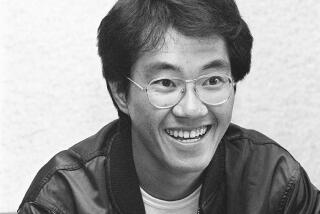Satoshi Kon dies at 46; Japanese anime director
Critically acclaimed animation director Satoshi Kon, creator of “Millennium Actress,” “Paprika” and “ Tokyo Godfathers,” died of pancreatic cancer Tuesday in Tokyo. He was 46.
FOR THE RECORD:
The headline on an earlier online version of this article incorrectly gave Satoshi Kon’s age as 47. As the story notes, Kon was 46.
In contrast to the musical fairy tales and comedy-adventures of American animated films, Kon’s films blurred the boundaries between fantasy and reality in unsettling ways. His boldly original visions and technical sophistication made him one of the most admired directors in contemporary animation. In Newsweek, David Ansen wrote that Kon “may be the most exciting Japanese animator since [ Hayao] Miyazaki.”
Dean DeBlois, co-director of DreamWorks’ “How to Train Your Dragon,” said, “Satoshi Kon used the hand-drawn medium to explore social stigmas and the human psyche, casting a light on our complexities in ways that might have failed in live action. Much of it was gritty, intense, and at times, even nightmarish. Kon didn’t shy away from mature subject matter or live-action sensibilities in his work, and his films will always occupy a fascinating middle ground between ‘cartoons’ and the world as we know it.”
Born in 1963 in Hokkaido, Japan, Kon made his debut as a manga (comic book) artist while a student at Musashino Art University. After graduation and a brief stint in the manga industry, he moved into animation, working as a designer and animator on “Roujin Z” (1991), a science fiction film written by “Akira” creator Katsuhiro Otomo. He then wrote the “Magnetic Rose” segment of the animated anthology “Memories” (1995).
Kon’s directorial debut, “Perfect Blue” (1998), impressed viewers on both sides of the Pacific. When young singer Mima quits a pop trio to pursue acting, angry fans stalk her in cyberspace and the real world until neither Mima nor the viewer knows where one ends and the other begins. The film gained wide exposure when Madonna showed clips from it during her Drowned World Tour in 2001.
Kon followed “Perfect Blue” with the less eerie and opulently beautiful “Millennium Actress” (2001). The film opens with documentarian Genya Tachibana interviewing reclusive former film star Chiyoko Fujiwara. As their conversation continues, Kon interpolates scenes from Chiyoko’s movies and memories. Tachibana and his blase cameraman are shocked to find themselves inside these visions.
“As a piece of visual legerdemain, as well as a rumination on the place movies have in our personal and collective subconscious, ‘Millennium Actress’ fascinatingly goes where films have not often gone before,” Times film critic Kenneth Turan wrote.
Kon’s “Tokyo Godfathers” (2003) was loosely based on John Ford’s 1948 film “3 Godfathers.” But instead of three cowboys, three homeless people in modern Tokyo find an abandoned infant. Other anime directors have set films in urban slums, but “Tokyo Godfathers” had a raw immediacy that shattered the popular image of a clean, affluent Japan. Kon used a gray-blue palette to suggest the bitter winter cold and the alienation of the characters from a society that disdains them.
Kon shifted from theatrical films to television for the profoundly unsettling “Paranoia Agent” (2004). At the end of the 13-episode series, the viewer is uncertain if the murderous child known as “Li’l Slugger” is a real character, the projection of a toy designer’s childhood trauma or a media creation.
Kon’s “Paprika” (2006) recently became the subject of widespread discussion on the Web, as many fans noted the similarities between its story about a doctor who enters people’s dreams to foil a sinister plot and Christopher Nolan’s hit movie “Inception.”
In an interview about “Paprika” with The Times in 2007, Kon reflected on the uncertain reality depicted in his films. “That quivering identity seems very ordinary in Japan, which does not have an absolute religion like Christianity, but multiple nature gods and goddesses. I’m sitting in L.A., answering your questions, but in my mind, I may be remembering work left in Tokyo and wondering what’s going to be for lunch today. Other people cannot experience that. So the experiences of the heroines in ‘Millennium Actress’ and ‘Perfect Blue’ could not normally be shared with an audience.”
At the time of his death, Kon was at work on his first children’s film, “The Dreaming Machine.” In 2007, he told the Singapore-based Straits Times, “From the children’s point of view, it will be an adventure and fantasy story that is exciting. But from an adult viewpoint, you can see another image. The kind of movie I want to make has a double life, a double meaning.” Masao Maruyama, Kon’s producer and president of the Madhouse animation studio, plans to complete “The Dreaming Machine.”
Kon’s survivors include his wife, Kyoko.
news.obits@latimes.com
More to Read
Start your day right
Sign up for Essential California for the L.A. Times biggest news, features and recommendations in your inbox six days a week.
You may occasionally receive promotional content from the Los Angeles Times.






